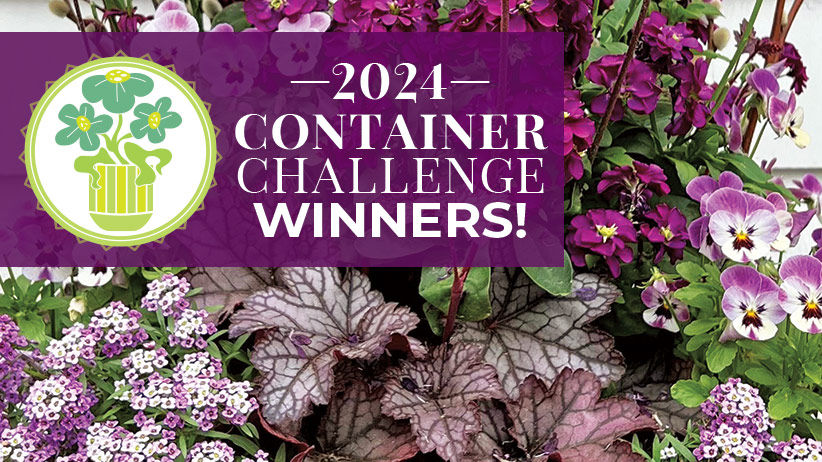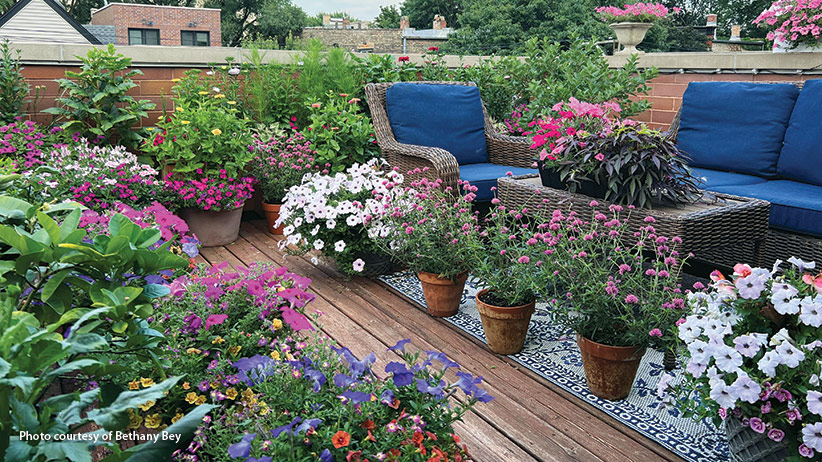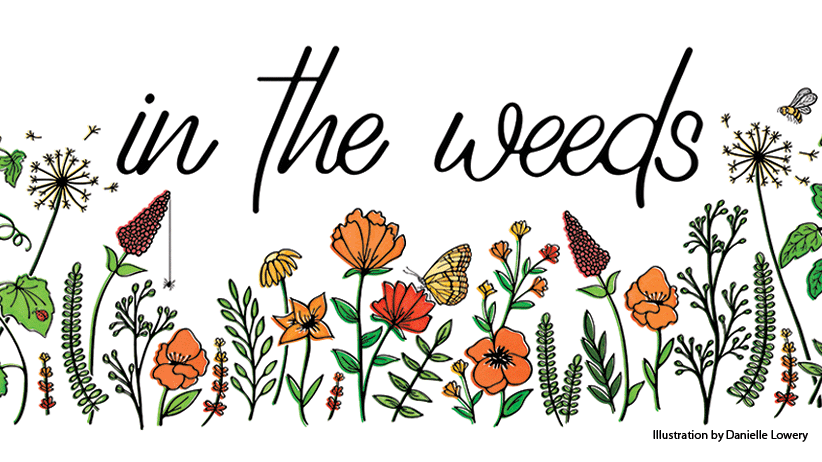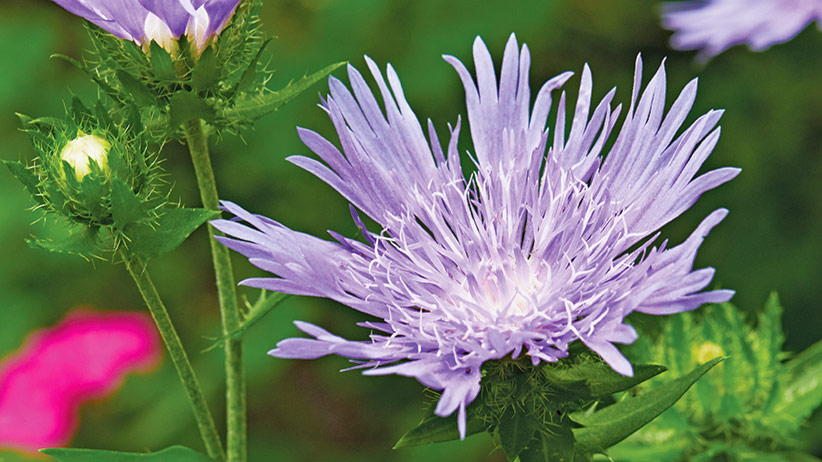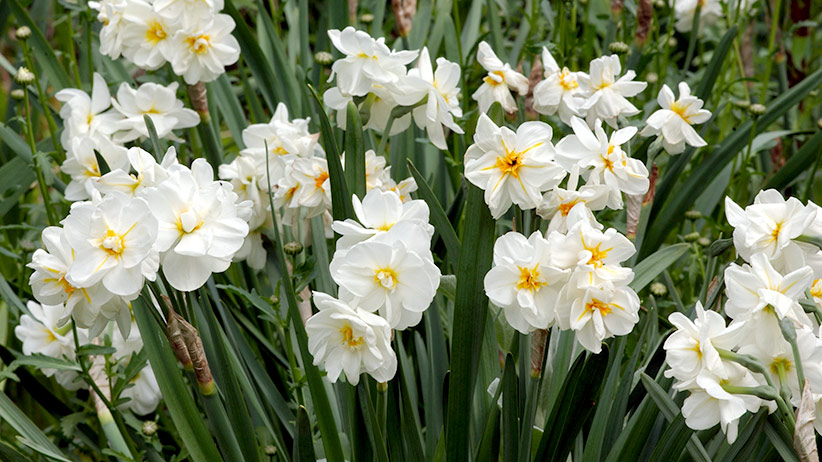
Choosing daffodils for your garden
When it comes to spring bulbs, nothing packs as much “flower power” as daffodils. Why? Well, because there’s a wide array of species and cultivars with a huge range of hardiness zones. Because of that, unlike other spring bulbs, there’s a daffodil for almost every part of the country — including your garden.
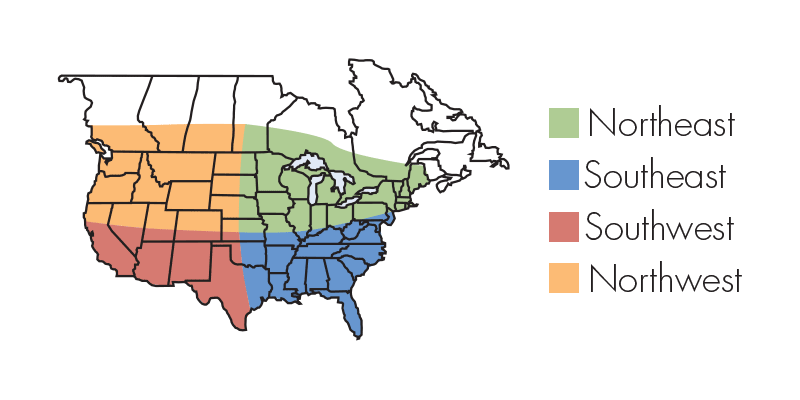
Daffodil reccomendations for your region
We’ve divided the United States and southern Canada into four areas with specific growing tips for each. Daffodils offer you easy-to-grow, long-lived color that you can enjoy every spring. And with so many to choose from, you’ll never run out of new ones to try! Scroll through to learn about the best daffodils for your region.
You Might Also Like:
Best Places to Buy Flower Bulbs Online
How to Plant Flower Bulbs
Watch Our Talk & Tour Garden Videos on YouTube
How to Grow Bulbs on a Budget
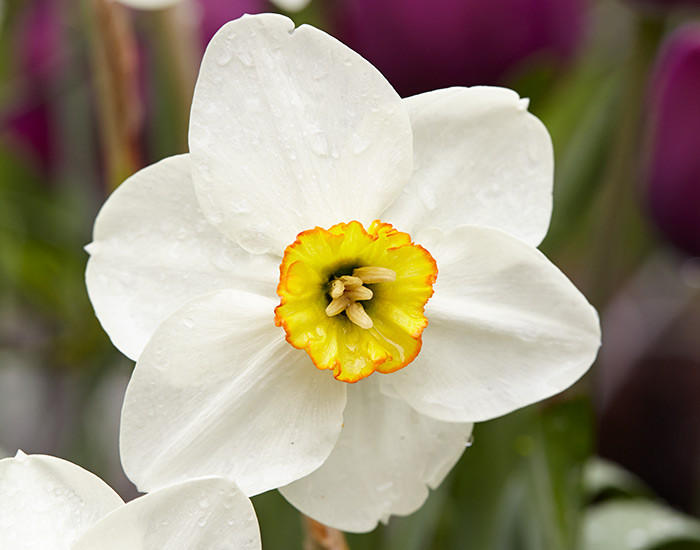
Best daffodils for the Northeast
Depending on your USDA zone, daffodils from almost every division (there are 12 official categories based on plant characteristics) grow here. About the only ones that don’t do well are the less-hardy tazettas and bulbocodiums. (And even these will grow along the coast where winters are milder.)
Growing tips
- In zones 3 to 6, if your autumn is dry, water the bulbs after planting to get the roots growing.
- For extra protection, put down a layer of chopped leaves or evergreen boughs once the soil freezes. Then pull the mulch away from the plants in early spring.
- Trumpet, large-cup, small-cup, cyclamineus, poeticus, split-corona and miniature daffodils perform well in the Northeast.
| Daffodil name (division) | Petals / Trumpet Color | Height | USDA Hardiness Zones | Bloom Time* | Also Thrives In | Comments |
|---|---|---|---|---|---|---|
| ‘Actaea’ (poeticus) | White / yellow | 15 to 17 in. | 3 to 7 | Mid- to late | SE, NW | Long-blooming; red band on cup; naturalizes well |
| ‘Beryl’ (cyclamineus) | Yellow / orange | 7 to 9 in. | 4 to 9 | Mid | SW, NW | hort, banded cup; heirloom narcissus |
| ‘Ceylon’ (large cup) | Deep yellow / orange-red | 14 to 16 in. | 4 to 8 | Early to mid | SE, NW | Long-lasting up-facing flowers; naturalizes well |
| ‘Cherry Spot’ (small cup) | White / bright orange | 14 to 17 in. | 4 to 8 | Mid- to late | NW | Flat orange cup; forces well indoors |
| ‘Dutch Master’ (trumpet) | All yellow | 18 to 20 in. | 4 to 8 | Early to mid | NW | Upward-facing cup; forces well indoors |
| ‘Tahiti’ (double) | Yellow / dark orange | 16 to 18 in. | 4 to 8 | Mid | NW | Striking, very double blooms |
| ‘Mount Hood’ (trumpet) | White / cream | 15 to 17 in. | 4 to 8 | Mid | NW | Cream cup ages to white |
| ‘Mary Gay Lirette’ (split corona) | White / salmon collar | 14 to 16 in. | 3 to 8 | Early to mid | NW | Large, ruffled cups start yellow, age to salmon |
| ‘Sweetness’ (jonquilla) | All yellow | 12 to 14 in. | 4 to 9 | Mid | SE, SW, NW | Very fragrant; forces well indoors |
| ‘Tete-a-Tete’ (miniature) | Yellow / dark yellow | 5 to 6 in. | 4 to 9 | Early | NW | Great for containers; forces well indoors |
You Might Also Like:
Try Our Bulb Calculator
11 Deer- and Rabbit-Resistant Plants
How to Buy the Best Bulbs
Best Flower Bulbs for Every region

Best daffodils for the Southeast
Since winters don’t get as cold here, plant bulbs about twice the bulb’s height, instead of the normal three times. Heavy summer rain and humidity can rot bulbs, so it’s best to plant them in raised or bermed beds with sharp drainage. Or you may need to lift and store them in a dry area over summer and replant them in the fall.
Growing tips
- To protect the planted bulbs from intense summer heat, place them where they’ll get part shade as the weather warms.
- In zones 8 and warmer, where spring is very brief, plant prechilled early and late-blooming cultivars as soon as you get them in fall. Water them in well, and give them a few good drinks through the winter if it’s dry.
- Jonquilla, tazetta, species and some large-cup cultivars work well in the Southeast.
| Daffodil name (division) | Petals / Trumpet Color | Height | USDA Hardiness Zones | Bloom Time* | Also Thrives In | Comments |
|---|---|---|---|---|---|---|
| ‘Avalanche’ (tazetta) | White / yellow | 16 to 18 in. | 6 to 9 | Mid- to late | SW, NW | Clusters of up to 20 flowers; sweet fragrance |
| ‘Waterperry’ (jonquilla) | White / yellow | 8 to 10 in. | 5 to 9 | Mid | SW, NW | Upward-facing yellow cups age to pink |
| ‘Pink Angel’ (jonquilla) | White / white | 12 to 14 in. | 4 to 8 | Mid- to late | SW, NW | Cup has pink rim; fragrant; three flowers per stem |
| ‘Geranium’ (tazetta) | White / red-orange | 15 to 17 in. | 5 to 9 | Late | SW, NW | Very fragrant; four to six flowers per stem |
| ‘Grand Soleil d’Or’ (tazetta) | Yellow / orange | 12 to 14 in. | 8 to 11 | Early | SW, NW | Fruity fragrance; forces well indoors |
| ‘Ice Follies’ (large cup) | Cream / light yellow | 16 to 18 in. | 4 to 8 | Early to mid | NW | Very popular; long-lasting; naturalizes well |
| ‘Pipit’ (jonquilla) | Yellow / white | 14 to 16 in. | 4 to 9 | Mid | SW, NW | Long bloomer; three to four flowers on each stem |
| ‘St. Keverne’ (large cup) | All yellow | 16 to 18 in. | 4 to 8 | Early | SW, NW | Showy flower; forces well indoors |
| ‘Sailboat’ (jonquilla) | Cream / yellow | 10 to 12 in. | 4 to 9 | Late | SW, NW | Fragrant, dainty white flowers with swept-back petals |
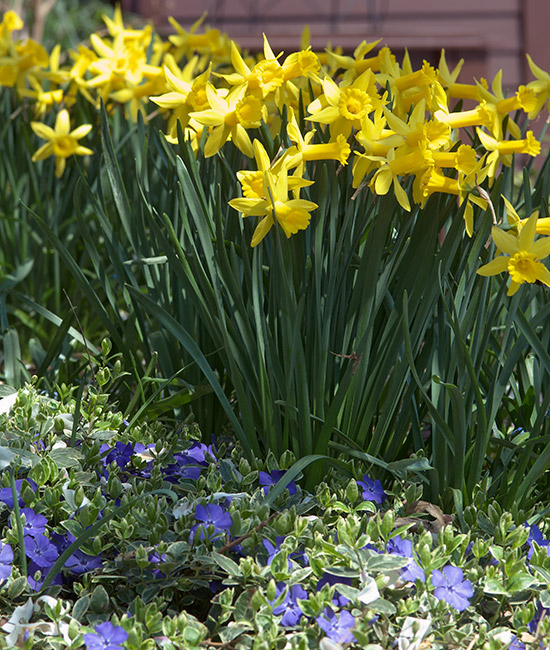
Best daffodils for the Southwest
You might be surprised to find that you can grow daffodils even in the hot, dry weather of the southernmost parts of this region. Triandrus, cyclamineus, jonquilla and tazetta are good choices for the Southwest.
Growing tip
- Jonquilla and tazetta cultivars actually prefer the summer heat, but you’ll probably need to water them through fall and again in spring.
| Daffodil name (division) | Petals / Trumpet Color | Height | USDA Hardiness Zones | Bloom Time* | Also Thrives In | Comments |
|---|---|---|---|---|---|---|
| ‘Chinese Sacred Lily’ (tazetta) | White / yellow | 10 to 14 in. | 8 to 11 | Early | SE, NW | May need staking; fragrant; forces well without chilling |
| ‘Katie Heath’ (triandrus) | White / pink | 12 to 14 in. | 4 to 9 | Mid | NW | Multiple fragrant, pendant blooms |
| ‘Erlicheer’ (tazetta) | Double white / ivory | 12 to 14 in. | 6 to 9 | Early to mid | SE, NE, NW | Very fragrant; protect from wind; forces well indoors |
| ‘Jetfire’ (cyclamineus) | Red-orange / yellow | 12 to 14 in. | 4 to 9 | Mid | NE, NW | Eye-catching in large drifts; naturalizes well |
| ‘Peeping Tom’ (cyclamineus) (in photo) | All yellow | 6 to 14 in. | 4 to 8 | Early to mid | s NE, NW | Long-lasting flowers with petals that curve backwards |
| ‘Sweet Love’ (jonquilla) | White / yellow | 12 to 16 in. | 4 to 9 | Mid | SE, NW | Sweet fragrance; lots of flowers on each stem |
| ‘Rapture’ (cyclamineus) | All yellow | 8 to 10 in. | 4 to 8 | Early | NE, NW | Petals flare back from long trumpet-shaped cup |
| ‘Thalia’ (triandrus) | All white | 12 to 14 in. | 4 to 9 | Mid- to late | NW | Petite, very fragrant flowers; naturalizes well |
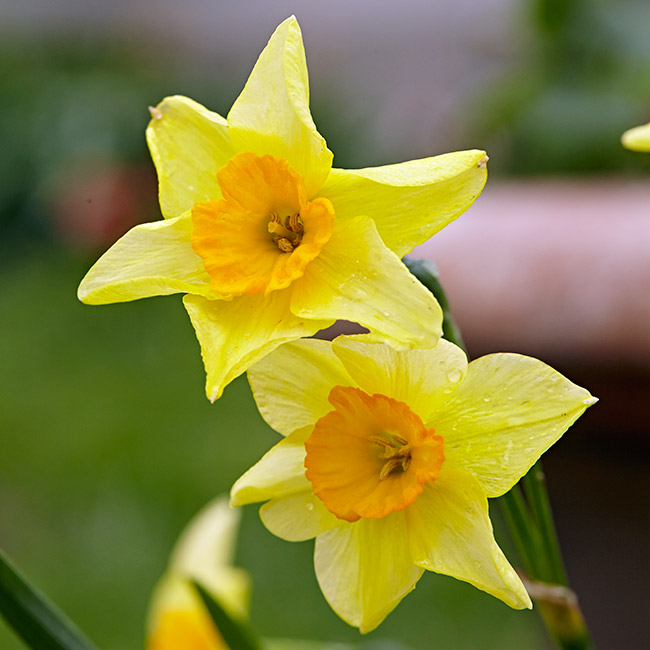
Best daffodils for the Northwest
Almost every type of daffodil will grow in the area west of the Rockies. Plant bulbs in the fall before the rainy season starts, but don’t water them or they’ll be more likely to rot before the weather cools down. If you regularly get more than 5 inches of rain per month in summer, lift the bulbs (except for tazettas, which tolerate some summer moisture) like gardeners in the Southeast should. Most daffodil types thrive in the Northwest.
| Daffodil name (division) | Petals / Trumpet Color | Height | USDA Hardiness Zones | Bloom Time* | Also Thrives In | Comments |
|---|---|---|---|---|---|---|
| ‘Baby Moon’ (miniature) | Yellow / gold | 4 to 8 in. | 5 to 9 | Late | SE, SW | Sweet fragrance; many flowers on each stem |
| ‘Barrett Browning’ (small cup) | White / orange-red | 14 to 16 in. | 4 to 8 | Early | NE | Forces and naturalizes well |
| ‘Cheerfulness’ (double) | White / light yellow | 14 to 16 in. | 4 to 9 | Late | NE | Fragrant, long-lasting blooms; naturalizes well |
| ‘Falconet’ (tazetta) (in photo) | Gold / orange | 12 to 14 in. | 5 to 9 | Mid | SE | Musky, sweet scent; up to eight flowers on each stem |
| ‘Felindre’ (poeticus) | White / yellow | 16 to 18 in. | 3 to 7 | Late | SE | Star-shaped petals; cup has red rim, green eye |
| ‘Fragrant Rose’ (large cup) | White / pink | 16 to 18 in. | 4 to 8 | Late | NE | Rose-scented; pink-purple cup has green-white eye |
| ‘Golden Bells’ (hoop petticoat) | All yellow | 7 to 8 in. | 5 to 9 | Mid | NE | Megaphone-shaped cup, narrow petals |
| ‘Ice Wings’ (triandrus) | All ivory-white | 10 to 12 in. | 4 to 9 | Early to mid | SW | Fragrant, long-lasting, nodding flowers |
| ‘Marieke’ (trumpet) | All yellow | 20 to 24 in. | 4 to 8 | Early | SE, SW | Long-lasting, upward-facing cut flower |
| ‘Mondragon’ (split corona) | Gold / orange collar | 13 to 17 in. | 4 to 8 | Mid | NE | Spectacular showy flowers with strong apple scent |
| ‘Surfside’ (cyclamineus) | Ivory / white | 12 to 14 in. | 4 to 9 | Mid | NE, SW | Large, showy, ruffled ivory cup |
Bloom time varies by area and elevation. For example, early cultivars may open in February in the Southeast and in April in the Northeast.








